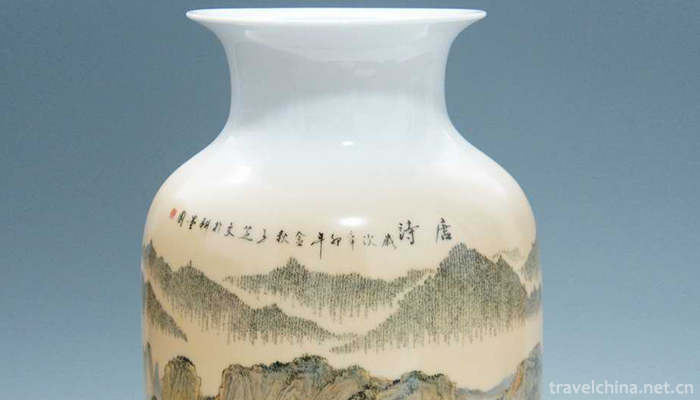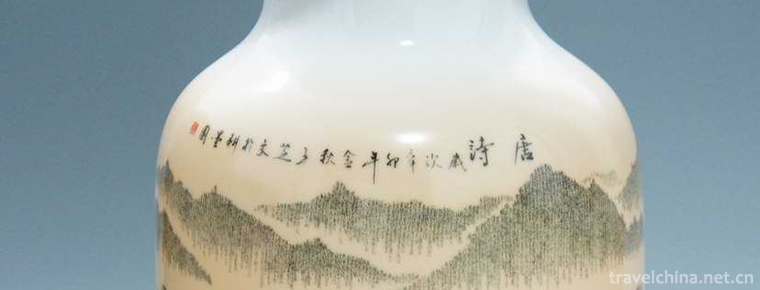Ceramic microbooks
Ceramic microbooks
Ceramic micro-calligraphy is one of the folk skills which perfectly combines Chinese calligraphy art with color porcelain art. It has a long history. Artists not only maintain the traditional style, but also constantly innovate. Now it has been listed as a "non-legacy project".
Micro-calligraphy is a kind of Chinese calligraphy art with a long history. There are almost all kinds of micro-book works from Liangzhu culture to dynasties. However, due to the combination of hands and hearts, and writing with naked eyes, each painting is clear, time-consuming and laborious, and it is very difficult. Few people can achieve this skill.
The creation of ceramic micro-books is arduous, the firing process is difficult, and the works are rare and precious.
In 2014, it was selected into the fourth batch of national intangible cultural heritage list.
Historical Origin
In order to inherit and carry forward the traditional Chinese culture and art, since 1985, Wang Zhiwen has inherited the study of predecessors, devoted himself to the research and creation of micro-books, and perfectly matched micro-books with porcelain, inherited the unique style and artistic essence of traditional porcelain crafts, and enhanced the value of art appreciation and collection. Ceramic micro-calligraphy is different from micro-sculpture and micro-sculpture in that it needs magnifying equipment, but only by writing with a special brush in naked view and then firing. The font is small enough to write more than 50 traditional Chinese characters on each square centimeter of porcelain surface. The combination of calligraphy and painting, brilliant color, fluent brushwork, exquisite color workers, distinct shades, fresh style, unique ingenuity, is a collection of calligraphy, painting, poetry, ancient prose, ceramics in one of the arts. The exquisite painting skills and remarkable achievements of micro-books have won people's high appreciation. Being recognized by Tsinghua University and domestic experts in Arts and crafts as having epoch-making significance and surpassing the innovative artistic skills of our ancestors, it not only inherits and develops the traditional micro-calligraphy skills of China, but also fills in the historical gap of China's porcelain art.
Main features
Compared with traditional calligraphy, ceramic micro-calligraphy has some special features, such as:
(1) Writing and painting on porcelain with special brushes and high temperature resistant pigments;
(2) Writing needle-sized calligraphy on ceramics with naked eyes without the aid of enlargement tools requires good psychological quality and creative perseverance;
(3) Pay attention to "Painting and Calligraphy Matching" to make micro-calligraphy works interesting and colourful. Some of the works are composed of characters and paintings from a distance, but when viewed close by a magnifying glass, the side is composed of fine pictures of micro-calligraphy. If there is a peony flower micro-calligraphy work, it is composed of more than 100,000 micro-calligraphy with pictures in words and characters in paintings, which are original.《 This work, 350,000 words, was written on a quiver over 50 centimeters high for seven years. It was finally fired successfully before it was completed. Its special technology can be seen.
(4) Selecting all kinds of special materials, such as Han Guang high-grade porcelain, porcelain plate, porcelain bottle and porcelain plate, to collect books, paintings, poems and lyrics on ceramic embryos, and then firing them into exquisite works, which have very elegant artistic appreciation and collection value.
(5) On the white and smooth porcelain, we make full use of the techniques of outlining, filling and washing and dyeing of the colored porcelain to combine the Meticulous Brushwork techniques of Chinese painting with the glaze painting techniques of the porcelain, giving people the feeling that it is not a traditional Chinese painting, which is better than a traditional Chinese painting. With a unique micro-book, it has its own style.
Important value
1. After painstaking research and creation, he originally created micro-books on ceramics, combining pottery, painting, poetry and classical literature, which is different from traditional calligraphy and micro-sculpture and micro-engraving by borrowing enlargement equipment, and inherits and develops folk art. Professor Zhang Shouzhi of Tsinghua University commented that Wang Zhiwen's artistic achievements should be said to be amazing, based on local culture, coupled with contemporary innovation, are Chinese, modern and world-wide. His works are collected by many units of the National Museum and the Palace Museum and are designated as national gifts for the outside Prime Minister by the relevant departments of the State; in the second consecutive session, the third "Chinese Nation Art Treasure Festival" was awarded as "Chinese Nation Art Treasure", and his works "Song Ci" are also treasured by the Chinese Nation Art Treasure Museum and become national treasures handed down from generation to generation and recorded in history.
2. To reproduce the long-lost micro-books, from the history of Chinese ceramics, there are Changsha kiln in the Tang Dynasty, Yue kiln in Zhejiang Province, Cizhou kiln system in the north, official kiln in Jingdezhen in the Yuan, Ming and Qing Dynasties, and literati porcelain developed from the Republic of China to modern Jingdezhen, all of which are the same system of calligraphy and painting, but no ceramic micro-books have been collected or unearthed. It is the first time in the history of Chinese porcelain that the whole volume of Chinese classical literature is written on a piece of ceramics. It fills in the gap of the combination of micro-calligraphy and ceramics, gains the protection of national intellectual property rights, and has high artistic appreciation value and historical collection value. Qiu Gengyu (professor, doctor, School of Fine Arts, Tsinghua University) said that Wang Zhiwen's way of making ceramic calligraphy art creation may not find a few such people in China, and has not been found up to now.
3. The creation of ceramic micro-books is arduous, the firing process is difficult, and the works are rare and precious.
There are few people who can persevere and persevere in learning ceramic micro-books, so Wang Zhiwen always uses Peng Yuanruijia's sentence "What's moving, February apricot blossom, August laurel: Who urges me, three more lights and five more chickens" to motivate himself to compete for seconds to create. Because, with the growth of age, people's eyesight, blood, strength decline, it will reserve a full stop and exclamation mark to you.


-
1.Helan Mountain Rock Painting
Helan Mountain Rock Painting is a national key cultural relics protection unit, the national AAAA level tourist attractions, the national research tourism demonstration base (2016 one of the first 20)
Time 2019-01-13 -
2.Baiyundong Tourist Area Kongshan
Baiyundong in Kongshan Mountain is a national key scenic spot, National Geological Park and national AAAA level scenic spot. Located in Lincheng County of Xingtai City
Time 2019-01-29 -
3.Nanxiang ancient town
Jiading Nanxiang Ancient Town is a national AAAAA scenic spot, located in Nanxiang Town, Jiading District, Shanghai. There are famous scenic spots such as brick pagoda, Guyiyuan, Hebi Mountain, Liuyun
Time 2019-02-07 -
4.Bo Ba Shen en
Bobassengen is a unique folk large-scale narrative mass pot village dance created by Ganbao Tibetan Village in Jiarong Tibetan area, Lixian County, Sichuan Province. "Boba"
Time 2019-04-04 -
5.Guilin fishing drum
Guilin fishing drum, commonly known as sentiment, is the local traditional rap and singing art of Guilin. The Song Dynasty was introduced into Guilin from the north,
Time 2019-05-02 -
6.Huatuo Wuqin Opera
Huatuo Wuqin Opera is a set of guiding techniques compiled by Huatuo, a famous physician in the late Eastern Han Dynasty, according to the principles of traditional Chinese medicine,
Time 2019-05-04 -
7.Cutting Copper Dus Cutting Copper
Painting inscriptions on bronze pots, smooth lines; beautiful paintings of mountains and rivers on bronze plates, such as immersion... In many people's eyes, Du's bronze engraving,
Time 2019-05-09 -
8.Li nationality firewood dance
The firewood dance is one of the representative folk dances of the Li nationality. It is called "Turn Brake" and "Taisha" in the Li dialect. It originated from the funeral custom o
Time 2019-05-12 -
9.Xihe Dagu
Xihe Drum is a form of drum script and drum music in northern China. It is one of the traditional quyiqu. It is widespread in Hebei Province and in the surrounding areas of Henan, Shandong, Beijing, T
Time 2019-06-30 -
10.Sachet
Incense bag is also called odor-tolerant, incense bag, incense bag, incense sauce, Pei Mo. Nowadays people call it purse, toy and dim. It is a folk embroidery handicraft created by ancient Chinese wor
Time 2019-07-03 -
11.Zeng Bu
Zeng bu (November 3, 1036 - August 21, 1107), Zi Zi Xuan, Tai Chang, son of Yi Zeng, brother Zeng Gong of Zhong Shu Shu, the Prime Minister of the Northern Song Dynasty, and the important supporter of
Time 2019-09-15 -
12.Video of Chengdu Giant Panda Base
It has been said to take the children to Chengdu Giant panda base to play, but because the new coronavirus epidemic did not go
Time 2020-12-13